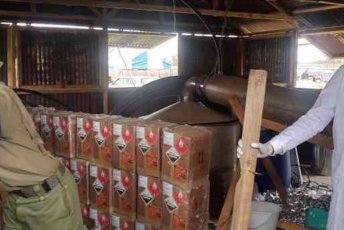On 30 January, armed robbers in Cape Town hijacked two members of a maintenance team loading automated teller machines (ATMs). They strapped a makeshift explosive device to one of the victims and forced him to open various ATMs in order to steal the cash. The victim was later released next to a highway.
The device comprised blasting cartridges similar to those smuggled across South Africa’s borders by organised crime syndicates. Members of the South African Police Service’s (SAPS) Cape Town Explosives Section, specialising in hazardous device incidents, defused the device and freed the victim, unharmed.
The illegal smuggling of explosives in South Africa is a disaster waiting to happen. Explosives are brought into the country predominantly from Zimbabwe, often by unsuspecting victims who find their way into the hands of organised criminals. The explosives are used to bomb ATMs, rob cash-in-transit vehicles, and in illegal mining operations.
The incident in Cape Town displays worrying tactics not used before by criminals in South Africa. Similar methods have however been reported over the past two decades in other parts of the world.
The Revolutionary Armed Forces of Colombia (FARC) terrorist group has often used the method. In 2000, FARC members strapped an explosive device around the neck of a woman not adhering to their extortion campaign against the local population. The bomb disposal technician who tried to render the device safe activated the bomb while defusing it, killing himself and the victim.
This incident was followed by another attempt by the same group targeting a farmer unwilling to pay extortion money. As with any new tactics employed by criminals, other organised crime groups in Colombia quickly began adopting these techniques.
In 2003, a pizza delivery man in Pennsylvania entered a bank with a similar device fitted around his neck and a note demanding US$250 000. He was stopped by police and the bomb squad was called. He told police that a gang had strapped the device to his body and handed him the note to rob the bank. The device was remotely detonated three minutes before the arrival of the bomb squad, killing the man.
In 2011, a similar device was tied around the neck of an 18-year-old Australian woman by an intruder in her house, who also left an extortion note. It took bomb technicians more than 10 hours to successfully defuse the bomb, which turned out to be a hoax.
The use of terror tactics by organised criminals is not a new phenomenon globally. Organised criminal networks share similarities with terrorists in that their methods are always evolving and adapting to law enforcement responses. Unlike terrorists, however, organised criminals’ ultimate aim is to maximise profits and reduce risks, rather than to draw attention to themselves.
In South Africa, tying an explosive device to the body of a victim is a new modus operandi. This shows that organised crime syndicates are willing to go to extreme levels by using stolen explosives to reach their goals. And it highlights the dangers that smuggled explosives play in the arsenal of organised criminals who are constantly adapting to responses by the police, the banking sector and the private security industry.
In the Cape Town incident, criminal syndicates used illegal explosives to achieve their goals of maximising profits with minimum risk to themselves. Ordinarily these offenders would use explosives to blow up an ATM, placing themselves and the public at risk. Here they showed not only a new modus operandi likely to be copied by others, but also something more directly aimed at human targets, and therefore potentially far deadlier.
A senior organised crime investigator who requested anonymity expressed his concern that explosives were now being used by syndicates as a tool of extortion. This tactic mirrors those used by suspected terrorist cells in KwaZulu-Natal province in recent years.
In 2018, one such cell linked to the Islamic State targeted various Woolworths, Spar and other outlets, as well as the Durban July horse race, in an elaborate extortion scheme with strategically placed improvised explosive devices. Members of the so-called Hoomer cell were arrested and put on trial where it emerged that their aim was to raise money for their terrorist activities.
The ease with which these criminals can obtain explosives underscores the need to urgently address the problem of smuggled explosives. But capacity and resource constraints undermine the police’s ability to act. The lack of intelligence sharing and collaboration among SAPS and other border control officials, among others, is also an issue.
A senior police commander in the police’s Explosives Section, who also requested anonymity, said, ‘Serious cuts in budgets for training and critical resources such as explosive consumables severely constrain the SAPS Explosives Section from performing essential tasks.’ He also said staff hadn’t received refresher courses for three years.
The delay in implementing the Explosives Act (Act 15 of 2003) and its supporting regulations is an even bigger problem. Police currently use an outdated law passed in 1956 and regulations passed in 1972 that don’t have mandatory obligations regarding tracking and tracing of explosives. This means that legal consumers can evade prosecution whenever explosives are lost or stolen.
Joint investigation task teams are needed to allow for inter-departmental intelligence sharing and collaborative operations. Detectives and prosecutors need the equipment and training to deal with explosives cases as there is little understanding of this specialised field. And unless the effective regulation of explosives is taken seriously, law enforcement will always find itself a step behind organised criminals.
Richard Chelin, Researcher and Willem Els, Senior Training Coordinator, ENACT, ISS Pretoria







